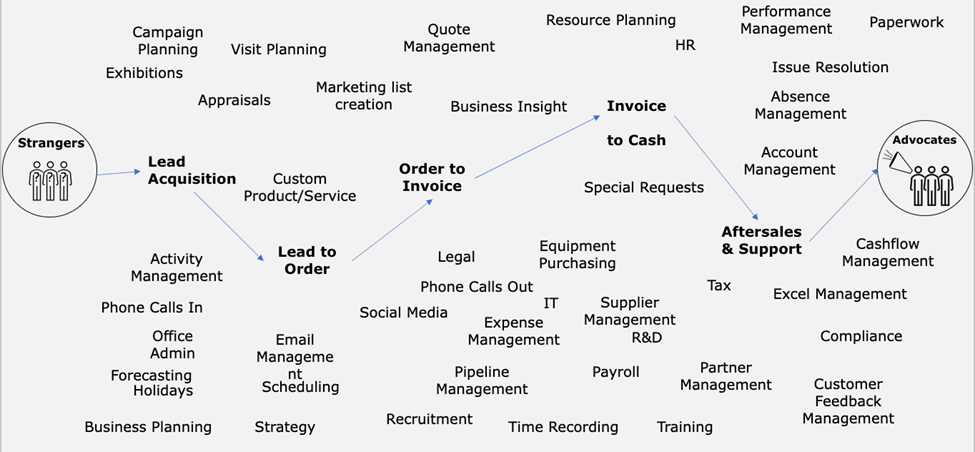The importance of foundation workflows
Foundation workflows are how your business achieves its purpose – but how do you know your foundation workflow is working effectively? Let’s dig into this important subject.
What is a workflow?
To begin – a reminder: what is a workflow? A workflow is a system for managing repetitive processes and tasks that occur in a particular order. They are the mechanism by which people and enterprises accomplish their work, whether manufacturing a product, providing a service, processing information, or any other value-generating activity.
Identifying your foundation workflow
All organisations have inputs and outputs. The workflow is what happens in between, taking you from one to the other. For example, turning strangers into advocates – a process that encompasses all aspects of marketing, sales, delivery and after-sales – is a common foundation workflow for all businesses. We call it a foundation workflow because it lays the foundation for your business.
Identifying your foundation workflow can be a challenge because there are so many tasks involved in getting from input to output, as shown in the diagram below. But by distinguishing between core and ‘feeder’ activities, you’re able to map a critical path. These are the core activities that make up the foundation workflow.

Your product or service offering could be amazing, but if this critical path is not working effectively, you won’t be able to turn strangers into advocates. That’s why the foundation workflow is so important.
The above example applies to most businesses. There are obviously other critical paths for other areas, like education or healthcare, but they all fall into the following broad categories (though not always in this order): acquire, deliver, administrate, after service.
Why your foundation workflow matters
Identifying your foundation workflow can take time, but it’s important work. Understanding your workflow, and how one task relates to another, enables you to streamline that workflow and create greater efficiency and a better customer and employee experience.
Identifying your critical path also enables you to dig deep into your workflow and find out what’s working, where you’re missing opportunities, and what can be improved. Benefits of foundation workflow assessment include:
- More insight into performance
- Ability to prioritise change and improvement
- Where to focus effort
- Reduction in micromanagement
- Responsibilities and accountabilities
- Effective communication
- Knowledge sharing
- Understanding other department’s challenges
In evaluating your foundation workflow, you identify opportunities for effective change – i.e. the changes to your workflow that have the biggest return across your business.
Case study: QGate
We’re sharing our own experiences with foundation workflow assessment to help you understand how this practice can help your business.
As a Microsoft professional services partner that supplies CRM software, we wanted to expand our range of services and provide more value to our clients. Having identified our foundation workflow – the business-typical workflow of lead to order, order to invoice, invoice to cash, and after sales and support – we conducted some due diligence on our ability to grow, measuring our foundation workflow performance against people, process and technology. We looked into our data to see where we were winning, where we needed to do more, and to provide a benchmark for future assessments. The research culminated in a graded assessment of each foundation workflow based on its ability to deliver our current services.
The results showed challenges to overcome in our sales and marketing and service departments, which, when set against our growth ambitions, showed that both performance and customer experience would be compromised if we pursued our growth strategy without change. Fortunately, we did this work in advance, so were able to put a plan in place to bolster our foundation workflow and manage the changes required to achieve our objectives.
Assessing foundation workflows
Identifying and understanding your foundation workflow ensures you have the framework you need to perform assessments that enable you to qualify the efficiency and effectiveness of this workflow. With those insights, you can improve – giving everyone involved a better experience.
As business process streamlining specialists, we would love to help you transform your processes to save time, money and increase efficiency. Contact us – we’d love to hear from you.


